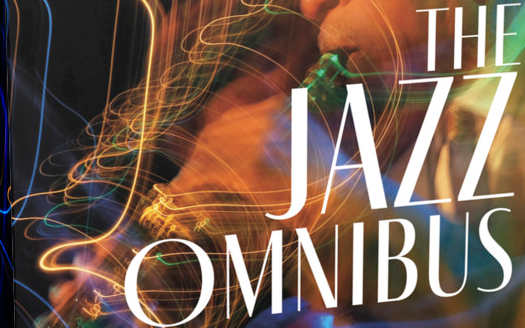In the making of The Jazz Omnibus: 21st-Century Photos and Writings by Members of the Jazz Journalists Association, the moment of truth arrived when Howard Mandel, president of the Jazz Journalists Association (JJA), found himself surrounded by 125 copies of the 600-page volume.
"125 books arrived, and I'm doing a mailing to more than 80 contributors, figuring out how to get them in their hands," Mandel recalls. "I thought, 'Oh good, the books have arrived! Now I can start getting them out to people!' Every time we got another proof, it was better, improved, fuller, richer." The finished product, released by Cymbal Press, brings together contributions from 90 writers and photographers, capturing today's jazz journalism.
The anthology's scope is remarkable: Ted Panken's intimate portrait of Sonny Rollins, Ashley Kahn's exploration of American jazz musicians making their homes in Europe, Nate Chinen's previously hard-to-find piece on Sun Ra, and Ted Gioia's examination of Amy Winehouse's relationship to jazz. But beyond the individual pieces, the book documents how jazz journalism has evolved in the 21st century.
"We weren't going out to write a history of the first quarter of the 21st century," Mandel explains. "We were showing what our members have done and what kind of coverage exists." This coverage spans reviews, interviews, analytical pieces, and what Mandel calls "quasi-academic writing," reflecting the diversity of approaches in contemporary jazz criticism.
I was fortunate to speak with the editorial team - Mandel, David R. Adler, and Terri Hinte – for an episode of The Buzz: The Jazz Journalists Association Podcast – who described the considerable challenge – and rewards - of curating and refining these contributions. With approximately 250 JJA members invited to submit up to three pieces each, the selection process balanced historical significance with fresh perspectives. "We were concerned when we looked through things and said 'how can we not have a piece about X,'" Mandel recalls, "but then we dug a little further and often had a piece around X."
Hinte, drawing on over 50 years of experience as a proofreader and copy editor, including working on thousands of album liner notes for Fantasy Records, brought a particularly keen eye to the project. "If I look at a page, the mistakes will jump out at me," she notes. The editorial process went far beyond simple proofreading - the team had to standardize submissions from diverse sources, create a comprehensive bibliography, and develop an index to help future researchers navigate the collection.
Adler, who had previously edited the JJA newsletter Jazz Notes, developed the book's organizational structure, creating sections with single-word themes like "Seekers," "Legends," "Scenes," and "Sounds." This framework helps readers navigate the extensive collection, including landmark pieces and hidden gems that might otherwise have been lost to digital impermanence.
The anthology is notably conscious of representation, featuring women as writers and subjects and deliberately reaching beyond New York-centric coverage to include international perspectives. Contributors from Canada, Europe, and beyond offer views of jazz that transcend traditional geographic boundaries, acknowledging the music's global reach in the 21st century. Including photography, curated by Patrick Hinely, adds important visual documentation to the historical record.
Hinely, reflecting on his role as photo editor emphasizes the collaborative nature of the visual elements: "I enjoyed getting to know, if only via e-mail, some of my colleagues from around the world." The photo reproduction quality proved particularly impactful, with Hinely noting his gratitude for the "professional attention to detail" that made the "imagery sing."
This volume sits within a distinguished lineage of jazz journalism collections, following the tradition of landmark works by Leonard Feather, Nat Hentoff, and Ira Gitler. Yet it differs from its predecessors in crucial ways, capturing the music and the changing nature of jazz journalism as it moves from print to digital media, from local to global perspectives, and from traditional criticism to more diverse forms of musical discourse.
For many contributors, the book offers something increasingly rare in digital journalism: permanence. "It infuriated me the way authors and artists and writers and journalists are being treated," says Gary Stager of Cymbal Press, "not just on the pay side... but from the investment of time and effort and inspiration that goes into writing something only to have it go out of print three or four months later, or to have a publisher who does nothing to promote it."
Some pieces, like Chinen's Sun Ra article, appeared in now-defunct publications. Others, like Eugene Marlow's personal account of befriending Bill Evans, gain new life in this format. Willard Jenkins' contribution delves into his development as a listener and professional, while Leslie Pintchik, both a writer and pianist, offers an insider's view of performance.
"Jazz is alive and well, flourishing in many ways, and books still matter," Stager observes. "There's a gravity to having been published in a book, and to have this stuff not mimeographed or not sitting on a blog allows people to take it seriously."
The project demonstrates the bonds within jazz journalism. Despite geographic dispersion - Adler now lives in England, and contributors span multiple continents - the book strengthened connections within the jazz writing community. "It's about strengthening our community," Adler reflects. "And we did that just merely by the act of getting this done."
In its thoroughness and attention to detail, The Jazz Omnibus joins the lineage of essential jazz journalism collections. It is a tremendous contribution to the literature, a tribute to the music, and a strong foundation for the next 100 years of the music.
Learn more about the Jazz Journalists Association, and their programs, which include annual awards, events, Jazz Heroes, and The Buzz: The JJA Podcast. Purchase The Jazz Omnibus: 21st-Century Photos and Writings by Members of the Jazz Journalists Association from Bookshop, Amazon, Barnes & Noble, and Powell’s.







Comments